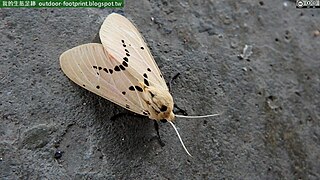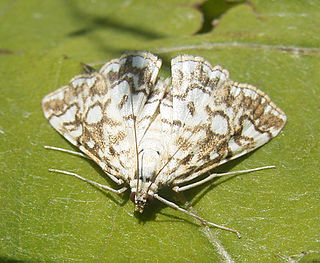Colonel Charles Swinhoe was an English naturalist and lepidopterist, who served in the British Army in India. He was one of the eight founders of the Bombay Natural History Society and a brother of the famous naturalist Robert Swinhoe.

The buff ermine is a moth of the family Erebidae. It is sometimes placed in the genus Spilosoma. The species was first described by Johann Siegfried Hufnagel in 1766. It is found throughout the temperate belt of the Palearctic region south to northern Turkey, Georgia, Kazakhstan, southern Siberia, eastern Mongolia, Amur Region, China, Korea and Japan.

Omiodes is a moth genus in the family Crambidae. Several species are endemic to Hawaii.

Digama is a genus of moths in the family Erebidae described by Frederic Moore in 1858. It is distributed in South Africa, China, throughout India, Sri Lanka, Myanmar and Australia.

Spilarctia is a genus of moths in the family Erebidae. The genus was erected by Arthur Gardiner Butler in 1875.

Rivula is a genus of moths in the family Erebidae described by Achille Guenée in 1845.

Chrysocraspeda is a genus of moths in the family Geometridae described by Charles Swinhoe in 1893.
Digama africana is a moth of the family Erebidae first described by Charles Swinhoe in 1907. It is found in Eritrea, Kenya and Tanzania.
Digama costimacula is a moth of the family Erebidae first described by Charles Swinhoe in 1907. It is found in Ghana, Kenya and Nigeria.
Digama lithosioides is a moth of the family Erebidae first described by Charles Swinhoe in 1907. It is found in Ethiopia, Tanzania and Zimbabwe.
Digama meridionalis is a moth of the family Erebidae first described by Charles Swinhoe in 1907. It is found in much of southern and eastern Africa.

Spilosoma sumatrana is a moth of the family Erebidae. It was described by Charles Swinhoe in 1905. It is found on Sumatra, Java and in Malaysia.

Acentropinae is a fairly small subfamily of the lepidopteran family Crambidae, the crambid snout moths. Species of this subfamily are exclusively found in wetlands and aquatic habitats.
Spilarctia accensa is a moth in the family Erebidae. It was described by Charles Swinhoe in 1903. It is found on Sumatra on Malacca.
Spilarctia hypogopa is a moth in the family Erebidae. It was described by George Hampson in 1907. It is found on Peninsular Malaysia, Sumatra and Borneo. The habitat consists of lowland forests and secondary vegetation.
Spilarctia ummera is a moth in the family Erebidae. It was described by Swinhoe in 1890. It is found in Myanmar.
Spilarctia coccinea is a moth in the family Erebidae. It was described by George Hampson in 1907. It is found in the Philippines.
Spilarctia mona is a moth in the family Erebidae. It was described by Charles Swinhoe in 1885. It is found in southern India.
Isocentris charopalis is a moth in the family Crambidae. It was described by Charles Swinhoe in 1907. It is found in the Democratic Republic of the Congo, South Africa, Zimbabwe and the Australian state of Queensland.






